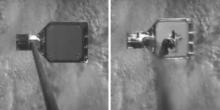We have a visitor from beyond our solar system, and the more information we gather, the more interesting things are becoming.
Comet 2I/Borisov is only the second “outsider” we have observed passing by, and based on early findings by astronomers, it seems to possess features just like comets that traverse our very own solar system. Additionally, 2I/Borisov has been observed to have a red hue, which makes it all the more intriguing.
Facts and Dates of Comet 2I/Borisov
Astronomers have confirmed Comet Borisov’s status as an interstellar object, whose route and speed indicate that it has come from beyond the known boundaries of our solar system.

The object has been observed to travel at the speed of 110,000 miles per hour. That’s faster than any man-made spacecraft that have traveled past the boundary of our solar system and which are now officially interstellar objects themselves. We’re talking about the Voyager probes that were launched in 1977.
2I/Borisov marks only the second instance of an interstellar object visiting from another solar system coming across ours. The first one was Oumuamua in 2017, a Hyperbolic asteroid whose odd elongated shape was most characterized as looking like a cigar.
While Oumuamua’s appearance was strikingly otherworldly, 2I/Borisov’s features appear more comet-like, as it were. As 2I/Borisov approaches ever so closer to our proximity, its brightness is expected to further increase its magnitude from 17 to 15 at its closest proximity, currently expected this coming December 28.
So far, several spectra of 2I/Borisov have been gathered from the William Herschel Telescope Canary Islands as well as the Gemini North telescope in Mauna Kea, Hawaii. Its slightly crimson colorings resemble that of the comets of our solar system, most notably Hale-Bopp in 1997.
While it is nothing more than just a faint body at this point in time, many amateur astronomers are hoping that they can get a closer look at 2I/Borisov once it arrives at its closest proximity to the sun, or more accurately, its perihelion. This is expected to happen around December 8.
Tips on Viewing Comet Borisov
With a 10-inch telescope under equivalent conditions, there is a legitimate and altogether alluring chance to view 2I/Borisov.
Visibility will be dependent on the DC values of the comet coma itself – that is, the degree of condensation.
A DC value of 0 indicates an object that is totally dispersed and spread out, with nil condensation at its core, while a DC value of 9 would indicate an object is so tightly packed and dense that it takes on the appearance of a star.
Size also plays an important factor when it comes to visibility. Bigger, more elongated objects are typically more difficult to recognize as opposed to the smaller, denser objects.
As of this writing, 2I/Borisov is characterized by a small, dense, and compact appearance. If it remains so all throughout the duration of its visit, veteran comet followers may be able to observe it through a 10-inch telescope.
Telescopes larger than 12 inches under dark, unlit conditions will have an even better chance of observing 2I/Borisov.
Regardless of what telescope is used, an important tip to keep in mind is to use a high magnification setting to concentrate on smaller objects while simultaneously darkening the background.
Environmental Conditions and the Perihelion (December 8)
Weather conditions, as well as those of altitude, will play a factor in determining whether observers will catch a glimpse of Comet Borisov. At its perihelion in December 8, cloudy skies often pose a challenge to comet observers located in the United States.
Borisov will be at its apex just before the break of dawn, particularly for the southern skies. And that would usually be 5 in the morning.
Comet 2I/Borisov is expected to be at its fullest, brightest manifestation from the beginning of December up until January 2020.
Comet observers situated in the north would do well to scour the skies at the beginning of December prior to the appearance of the waxing moon expected at around December 11. Moonless skies are expected to return on the 22nd, bidding well for observers, particularly for observers in the south and further. They will get to enjoy the most opportunities to enjoy the tastiest views of Borisov for the duration of its stay.
Comets continue to retain their intriguing appeal in spite of the march of time. In fact, comets are further getting shrouded in mystery as time goes by. They raise the same interest and thirst for knowledge that were never fully answered each time they appear. It is this same allure that inspires comet observers of all walks of life and of all locations to search, to ask, and to question. Happy hunting.




i live in the northern hemisphere, around what time of night will it appear?